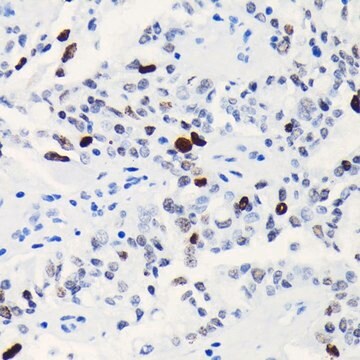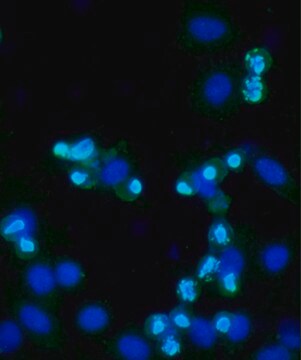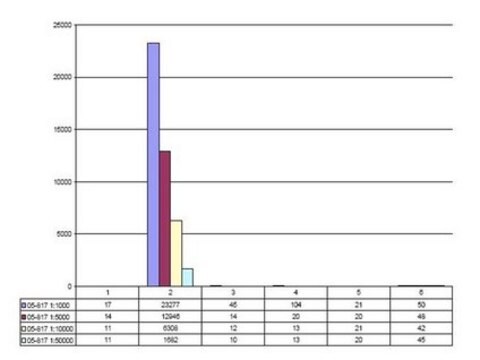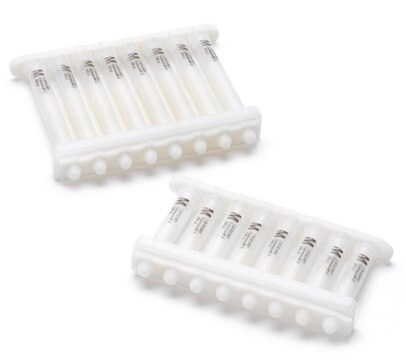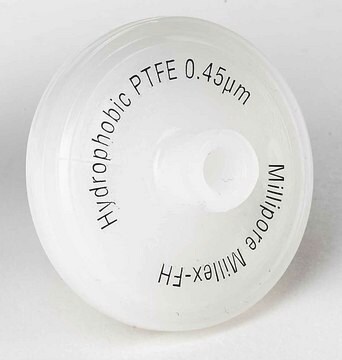17-10269
ChIPAb+ Phospho-Histone H3 (Ser28) Antibody
from rabbit, purified by affinity chromatography
Synonym(e):
Histone H3.1t, H3/t, H3t, H3/g
About This Item
Empfohlene Produkte
Biologische Quelle
rabbit
Qualitätsniveau
Antikörperform
affinity purified immunoglobulin
Klon
polyclonal
Aufgereinigt durch
affinity chromatography
Speziesreaktivität
mouse, human
Hersteller/Markenname
ChIPAb+
Upstate®
Methode(n)
ChIP: suitable
dot blot: suitable
immunocytochemistry: suitable
inhibition assay: suitable (peptide)
western blot: suitable
NCBI-Hinterlegungsnummer
UniProt-Hinterlegungsnummer
Versandbedingung
dry ice
Allgemeine Beschreibung
The ChIPAb+ Phospho-Histone H3 (Ser28) set includes the Phospho-Histone H3 (Ser28) antibody, a Normal Rabbit IgG, and control primers which amplify a 166 bp region of the human GAPDH promoter. The Phospho-Histone H3 (Ser28) and negative controls are supplied in a scalable "per ChIP" reaction size and can be used to functionally validate the precipitation of Phospho-Histone H3 (Ser28)-associated chromatin.
Immunogen
Anwendung
Epigenetik & nukleäre Funktionen
Histone
Representative lot data.
Sonicated chromatin prepared from untreated or colcemid-treated HeLa cells (1 X 106 cell equivalents per IP) were subjected to chromatin immunoprecipitation using either 5 µl Normal rabbit IgG, or 5 µl Anti-phospho-Histone H3 (Ser28) and the Magna ChIP® A Kit (Cat. # 17-610). Successful immunoprecipitation of phospho-Histone H3 (Ser28)- associated DNA fragments was verified by qPCR using ChIP Primers, human GAPDH promoter region for untreated and treated chromatin samples (Figure 2). Data is presented as percent input of each IP sample relative to input chromatin for each amplicon and ChIP sample as indicated.
Please refer to the EZ-Magna ChIP A (Cat. # 17-408) or EZ-ChIP (Cat. # 17-371) protocol for experimental details.
Western Blot Analysis:
Representative lot data.
HeLa acid extract (lane 1) and recombinant Histone H3 (lane 2) were probed with Anti-phospho-Histone H3 (Ser28) (1:2,000 dilution).
Proteins were visualized using a Donkey Anti-Rabbit IgG secondary antibody conjugated to HRP and a chemiluminescence detection system. (Figure 3)
Arrow indicates phospho-Histone H3 (Ser28) (~17 kDa).
Dot Blot Specificity Analysis:
Representative lot data.
Histone peptides with various modifications (see table) were probed with Anti-phospho-Histone H3 (Ser28). Proteins were visualized using a Donkey Anti-Rabbit IgG secondary antibody conjugated to HRP and a chemiluminescence detection system. (Figure 4)
Immunocytochemistry Analysis
Representative lot data
Confocal fluorescent analysis of HeLa cells using Anti-phospho-Histone H3 (Ser28) (Red). Actin filaments have been labeled with AlexaFluor 488 dye-Phalloidin (Green). Nucleus is stained with DAPI (Blue). This antibody positively stains the mitotic cell nucleus. (Figure 5)
Peptide Inhibition Assay: A 1:500 dilution from a representative lot was blocked by phospho-Histone H3 (Ser28) peptides, but not non-specific peptides.
Verpackung
Qualität
Representative lot data.
Sonicated chromatin prepared from colcemid-treated HeLa cells (1 X 106 cell equivalents per IP) were subjected to chromatin immunoprecipitation using either 5 µl Normal rabbit IgG, or 5 µl Anti-phospho-Histone H3 (Ser28) and the Magna ChIP® A Kit (Cat. # 17-610). Successful immunoprecipitation of phospho-Histone H3 (Ser28)-associated DNA fragments was verified by qPCR using ChIP Primers, human GAPDH promoter region (Figure 1).
Please refer to the EZ-Magna ChIP A (Cat. # 17-408) or EZ-ChIP (Cat. # 17-371) protocol for experimental details.
Zielbeschreibung
Physikalische Form
Normal Rabbit IgG. Two vials containing 75 μL of normal rabbit IgG in buffer containing 0.01M PBS with 0.1% sodium azide. Store at -20°C.
ChIP Primers, human GAPDH promoter. One vial containing 75 μL of 5 μM each primer specific for human GAPDH. Store at -20°C.
FOR: TAC TAG CGG TTT TAC GGG CG
REV: TCG AAC AGG AGG AGC AGA GAG CGA
Lagerung und Haltbarkeit
Note: Variability in freezer temperatures below -20°C may cause glycerol containing solutions to become frozen during storage.
Hinweis zur Analyse
Includes normal rabbit IgG and primers specific for human GAPDH promoter
Rechtliche Hinweise
Haftungsausschluss
Lagerklassenschlüssel
10 - Combustible liquids
Analysenzertifikate (COA)
Suchen Sie nach Analysenzertifikate (COA), indem Sie die Lot-/Chargennummer des Produkts eingeben. Lot- und Chargennummern sind auf dem Produktetikett hinter den Wörtern ‘Lot’ oder ‘Batch’ (Lot oder Charge) zu finden.
Besitzen Sie dieses Produkt bereits?
In der Dokumentenbibliothek finden Sie die Dokumentation zu den Produkten, die Sie kürzlich erworben haben.
Unser Team von Wissenschaftlern verfügt über Erfahrung in allen Forschungsbereichen einschließlich Life Science, Materialwissenschaften, chemischer Synthese, Chromatographie, Analytik und vielen mehr..
Setzen Sie sich mit dem technischen Dienst in Verbindung.



